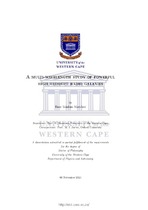| dc.description.abstract | We present a new sample of distant powerful radio galaxies, in order to study their
host-galaxy properties and provide targets for future observations of Hi absorption
with new radio telescopes. We cross-match the Sydney University Molonglo Sky
Survey radio catalogue at 843 MHz with the VISTA Hemisphere Survey near-infrared
catalogue using the Likelihood Ratio technique, producing contour plots as a way to
inspect by eye a subset of bright sources to validate the automated technique. We
then use the Dark Energy Survey optical and near-infrared wavelength data to obtain
photometric redshifts of the radio sources. We find a total of 249 radio sources with
photometric redshifts over a 148 square degree region. By fitting the optical and
near-infrared photometry with spectral synthesis models, we determine the stellar
masses and star-formation rates of the radio sources. We find typical stellar masses of
1011−1012 M for the powerful high-redshift radio galaxies. We also find a population
of low-mass blue galaxies. We then report results from the first search for associated
Hi 21 cm line absorption with the new MeerKAT radio telescope (shared-risk early
science programme). We used a 16-antenna sub-array of MeerKAT to carry out
a survey for Hi absorption in the host galaxies of nine powerful (L1.4 GHz > 1026
W Hz−1
) radio galaxies at cosmological distances (z = 0.29 to 0.54). We found
no evidence of absorption with 5σ optical depth detection limits. We only obtain
a tentative absorption towards a radio source 3C 262 at z = 0.44 with significant
ongoing star formation at a rate of 10.5 M yr−1
. The source consists of two radio
lobes separated by 28.5 kpc with no evidence of a compact core. If the absorption
arises from neutral gas from an extended disc, the line is redshifted by 79(21) km s−1
with respect to the nucleus and has an average Hi column density across the source
of NHI ∼ 7 × 1019−20 cm−2
, which is consistent with the rate of star formation. But
after further tests, we find that the Hi detection towards 3C 262 is likely to be an
artefact. We conclude that the new correlator with 32 k channel resolution will be
needed before searching for its associated absorption in MIGHTEE data. | en_US |

